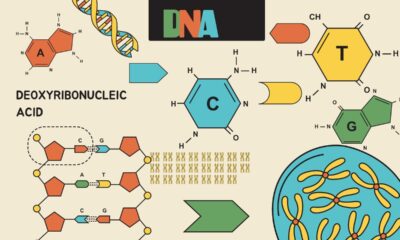Articles
Humanity is losing the ability to make decisions

What on the one hand simply makes work easier, but on the other hand also means that several decisions are made for you. The AI decides which pages it visits, the AI decides which recipe is selected at the end. This may not have major consequences for pizza dough, but if you think about it further, according to Árvai, AI will definitely have an impact on our ability to make decisions in the long term.
As artificial intelligence continues to advance, there’s a growing concern that humanity is gradually relinquishing its ability to make decisions. With AI systems increasingly permeating various aspects of our lives, from recommendation algorithms shaping our preferences to automated processes making choices on our behalf, there’s a sense that our autonomy is diminishing. While AI offers unparalleled efficiency and convenience, there’s a risk of becoming overly reliant on its suggestions and predictions, potentially eroding our critical thinking skills and independent judgment. Moreover, the opacity of some AI algorithms and their susceptibility to biases raise questions about the transparency and fairness of the decisions they make. As we navigate this evolving landscape, it’s crucial to strike a balance between harnessing the benefits of AI and preserving our capacity for conscious decision-making, ensuring that technology remains a tool that augments rather than replaces human agency.
The opaque nature of artificial intelligence, often likened to a black box, raises significant concerns about the extent of human understanding and control over the decisions it makes. A substantial portion of AI’s decision-making process remains hidden from users, making it challenging to comprehend the rationale behind its conclusions. As AI models increasingly assume responsibility for critical decisions across various domains, there’s a looming apprehension that humans may gradually forfeit their capacity for independent decision-making in the long term. Without visibility into the inner workings of AI systems, individuals may become increasingly reliant on their outputs, potentially diminishing their ability to critically assess information and make informed choices. Safeguarding against this scenario necessitates efforts to enhance transparency in AI algorithms and empower users with the knowledge and tools to comprehend and scrutinize the decisions made by these systems. By fostering transparency and accountability, we can mitigate the risk of ceding control over decision-making processes to AI and preserve the essential role of human agency in shaping our collective future.
Articles
Spintronics
Spintronics, short for spin transport electronics, represents a revolutionary paradigm in electronics that harnesses the intrinsic spin of electrons, in addition to their charge, to store, process, and transmit information. Unlike conventional electronics, which rely solely on the charge of electrons to represent data as binary digits (0s and 1s), spintronics exploits both the charge and spin of electrons, offering advantages in speed, efficiency, and functionality.
At the heart of spintronics lies the concept of electron spin, an intrinsic property of electrons analogous to the spinning of a tiny magnet. In spintronics, information is encoded not only in the presence or absence of charge carriers but also in the orientation of their spins, which can point up or down. This additional degree of freedom enables spintronic devices to store and manipulate data in ways that surpass the limitations of traditional electronics.
One of the key components of spintronics is the spin valve, a device that exploits the phenomenon of giant magnetoresistance (GMR). GMR occurs when the resistance of a material changes in response to the relative orientation of its magnetic layers. By controlling the alignment of these layers, spin valves can modulate the flow of electrons based on their spin orientation, allowing for the creation of spin-based memory and logic devices.
Spintronics has already found applications in various fields, including magnetic data storage, where it has enabled the development of higher-density and more energy-efficient hard disk drives. Spin-based memory technologies, such as magnetic random-access memory (MRAM), offer non-volatile storage with fast read and write times, making them promising candidates for next-generation computing architectures.
Spintronics holds potential for novel computing paradigms beyond von Neumann architectures. Spin-based logic devices, such as spin transistors and spin-based logic gates, could pave the way for spin-based computing, where information processing is performed directly using electron spin rather than charge. This approach could lead to ultra-low-power and high-speed computing systems with enhanced functionality and scalability.
In addition to computing, spintronics has implications for spin-based sensing and quantum technologies. Spin-based sensors, such as magnetometers and spin-based gyroscopes, offer high sensitivity and precision for applications in navigation, medical imaging, and environmental monitoring. Furthermore, spin qubits, which leverage the quantum properties of electron spin, are being explored for quantum computing and quantum communication applications, promising unprecedented computational power and secure communication channels.
As research in spintronics continues to advance, the potential for transformative technologies across a wide range of applications continues to grow. From faster and more energy-efficient electronics to quantum computing and beyond, spintronics represents a frontier where the quantum nature of electrons unlocks new opportunities for innovation and discovery.
Articles
Electron universe
In the vast landscape of quantum physics, where the rules of the microscopic world govern the behavior of particles and materials, a fascinating conceptual framework has emerged: the “electron universe.” Unlike the grand cosmos that stretches across galaxies and stars, this universe delves into the intricate structure of electronic quantum states within magnetic materials, revealing a cosmos-like complexity within the confines of everyday conditions. In this article, we embark on a journey to understand the essence of the electron universe and how it parallels the structure of the cosmos itself.
Unveiling the Quantum Cosmos
At the heart of the electron universe lies the enigmatic behavior of electrons, the fundamental particles that orchestrate the properties of matter. In magnetic materials, such as iron, nickel, and cobalt, electrons exhibit remarkable characteristics that define the material’s magnetic properties. Under everyday conditions, these materials host a myriad of electronic quantum states, each contributing to the overall magnetic behavior in a manner akin to celestial bodies shaping the cosmic landscape.
The Quantum Dance of Electrons
Within the electron universe, electrons engage in a mesmerizing dance dictated by the laws of quantum mechanics. Quantum states, represented by wave functions, describe the probability distribution of finding an electron at a given position and energy level within the material. Just as stars and planets gravitate around each other in the cosmos, electrons interact with each other and with the atomic lattice, creating complex patterns of magnetic order that permeate the material’s structure.
Magnetic Marvels
Magnetic materials harbor a rich tapestry of phenomena that reflect the intricacies of the electron universe. From ferromagnetism, where electron spins align to produce a strong magnetic field, to exotic phenomena like spin waves and magnetic domains, the behavior of electrons orchestrates a symphony of magnetic effects that shape our technological landscape. Understanding and harnessing these phenomena hold the key to developing advanced magnetic materials for applications ranging from data storage to spintronics.
Exploring New Frontiers
As we delve deeper into the electron universe, we uncover new frontiers and phenomena that challenge our understanding of the quantum world. Emergent phenomena, such as topological insulators and quantum spin liquids, blur the boundaries between conventional states of matter, paving the way for novel discoveries and applications. Moreover, the quest for room-temperature superconductors and quantum computing materials drives researchers to push the boundaries of our knowledge, promising breakthroughs that could revolutionize technology.
The electron universe presents a captivating parallel to the grandeur of the cosmos, revealing a cosmos-like complexity within the realm of quantum materials. As we continue to unravel the mysteries of electronic quantum states within magnetic materials, we gain deeper insights into the fundamental nature of matter and the universe itself. By exploring the electron universe, we not only expand our scientific understanding but also unlock new possibilities for technological innovation and exploration.
Articles
Quantum state
In the realm of quantum mechanics, a quantum state embodies the complete description of a quantum system. Unlike classical physics, where properties like position and momentum can be precisely determined, quantum mechanics introduces a level of uncertainty. A quantum state encapsulates all possible outcomes and probabilities associated with observing various properties of a particle or system. It’s often represented by a mathematical construct called a wave function, which evolves over time according to the Schrödinger equation. This equation dictates how the quantum state changes in response to external influences, allowing scientists to predict the behavior of particles on the atomic and subatomic scales.
One of the most intriguing aspects of quantum states is superposition, where a particle can exist in multiple states simultaneously. This concept, famously illustrated by Schrödinger’s thought experiment involving a cat both alive and dead, challenges our classical intuition. Moreover, entanglement adds another layer of complexity. When particles become entangled, the quantum state of one particle becomes dependent on the state of another, regardless of the distance between them. This phenomenon, famously termed “spooky action at a distance” by Einstein, has profound implications for quantum computing and cryptography.
The act of measurement in quantum mechanics plays a pivotal role in determining the state of a system. According to the Copenhagen interpretation, the act of measurement causes the quantum state to collapse into one of its possible outcomes, effectively determining the observed result. This collapse of the wave function remains a subject of debate and scrutiny among physicists, illustrating the fundamental mysteries at the heart of quantum mechanics. Despite its enigmatic nature, understanding and harnessing quantum states have led to revolutionary advancements in technology, promising a future where quantum computers, sensors, and communication systems redefine the boundaries of what’s possible.
-

 Engineering4 days ago
Engineering4 days agoElectromobility
-

 IT4 days ago
IT4 days agoLenovo and Motorola smartphones
-
Articles2 days ago
Diversity of solar system
-

 News2 weeks ago
News2 weeks agoChatBot – Increasing popularity
-

 Engineering1 day ago
Engineering1 day agoOnline computer science degree
-

 Geography2 days ago
Geography2 days agoNet zero emissions
-

 Technology2 days ago
Technology2 days agoArtificial Intelligence – Breast Cancer Screening
-

 Science4 days ago
Science4 days agoAI tool – Finding Building blocks of life




